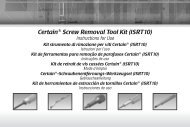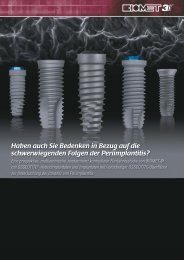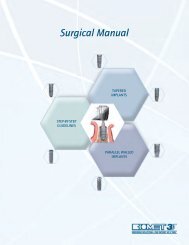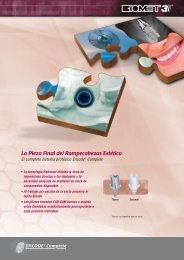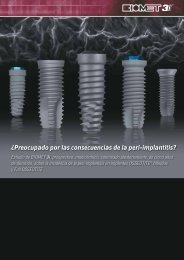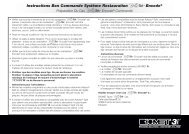Create successful ePaper yourself
Turn your PDF publications into a flip-book with our unique Google optimized e-Paper software.
Introduction<br />
Implant & Abutment System Connections<br />
External Hex Connection<br />
The external hex connection implant and abutment designs have been<br />
widely used in implant dentistry.<br />
• Gold Standard ZR (Zero Rotation) is a patented design incorporating<br />
machined microstops within the corners of the hex in the abutment.<br />
The design reduces horizontal rotation between the implant and<br />
abutment. Gold Standard ZR is available on UCLA, GingiHue ® and<br />
Conical Abutments.<br />
• The 12-point double hex, which is machined in the 15º Pre-Angled<br />
GingiHue Abutment, provides rotational positioning in 30º increments<br />
on the implant hex.<br />
• Precise Abutment Placement: The ASYST Abutment Placement Tool<br />
provides fingertip control for fast and easy abutment delivery. The<br />
patented packaging design makes abutment placement easier because the<br />
abutment is delivered sterile from the package directly to the implant site.<br />
The abutment and abutment screw are packaged inside the plastic ASYST<br />
seating device. The plastic seating device facilitates precise placement of<br />
the abutment on the implant, thus reducing chair time. The ASYST Tool is<br />
packaged with Low Profile, Standard and Conical Abutments.<br />
• Impression Copings: Pick-Up and Twist Lock Transfer Copings are both<br />
available in the external connection design in three EP ® (Emergence<br />
Profile) diameters and a straight diameter to match the corresponding<br />
healing abutment. The patented Twist Lock design provides a more<br />
accurate transfer of the implant connection as compared to other<br />
transfer (closed tray) techniques. This unique Twist Lock feature provides<br />
a series of undercuts to guide the coping into the impression, giving<br />
stability to the impression coping/analog prior to pouring the impression.<br />
As a result, the copings lock into orientation grooves upon clockwise<br />
rotation, thereby allowing for a tactile sensation of resistance that ensures<br />
an accurate hex transfer.<br />
iii



